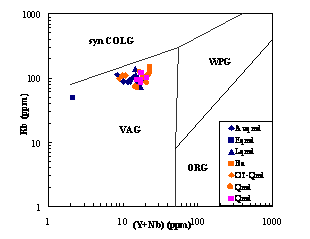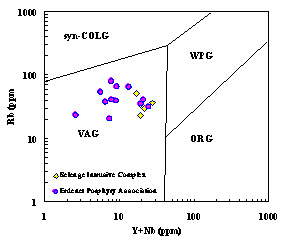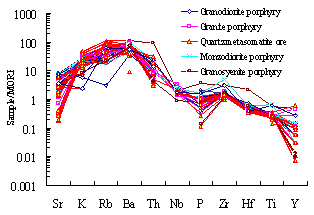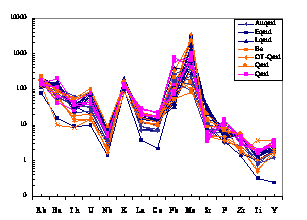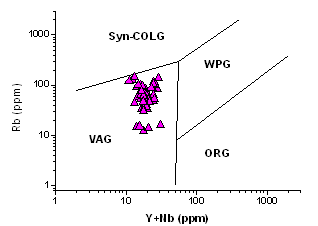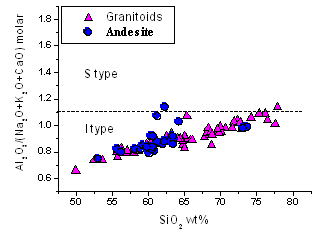|
GRANITOIDS and associated MINERALIZATION in Mongolia: with emphasase to porphyry systems Ochir G.*, Rinchen O.** *Dept. of Geology, Mongolian University of Science & Technology, Ulaanbaatar, Mongolia, gerel@must.edu.mn **Ivanhoe Mines Mongolia Inc., Ulaanbaatar, Mongolia
Granitoids occupy about 30% of the Mongolian territory, which is a part of Altaids (Sengior & Natal’in, 1996), or Central Asian Orogenic Belt (Zonenshain et al., 1990), or Central Asian supercollage (Yakubchuk, 2004), formed by accretion of island arc and microcontinents (Badarch et al., 2002). Granitoids are mainly represented by calc-alkaline I type formed in island arc or continental arc environment. Ore deposits associated with granitoids are represented by porphyry Cu-Mo and Cu-Au, W-Sn, vein Au, and intrusion-related Ag-Pb-Zn, and alkaline rock hosted Zr-Nb-REE. Metallogenesis of granite-hosted ore deposits is closely linked to nature of their associated granitoids. Intrusion-related metallogenic provinces of Phanerozoic age with Cu-Mo and Cu-Au porphyry mineralization are developed under subduction zones in northern, middle and south Mongolia (Fig.1).
Fig. 1. Porphyry Cu-Au and Cu-Mo deposits in Mongolia associated with granitoids.
Porphyry Cu-Mo deposits and occurrences are associated with typical calc-alkaline metaluminous, oxidized, I type, magnetite series granitoids, which is dominated granitoid type in Mongolia. They form oceanic volcanic arc (Devonian porphyry-Cu-Au deposits Oyu tolgoi in South Mongolia), late Paleozoic and early Mesozoic continental arc porphyry Cu-Mo deposits (Bayan uul, Erdenet). The ore-bearing porphyritic rocks form stocks or dikes, and are the youngest of calc-alkaline belts, tectonically linked to subduction zone. Porphyritic rocks have typical features characteristic for arc environment (Fig. 2 and 3) Porphyry Cu-Au-related intrusions at Oyu Tolgoi have fine-grained (< 5mm) textures, that vary from equigranular to crystal-crowded porphyritic, and range in composition from quartz monzodiorite to granodiorite. Plagioclase and K-feldspar are dominant mineral phases; original ferromagnesian minerals are not preserved due to intense alteration, but pseudomorphs suggest that hornblende may be the main phase. Accessory minerals include apatite, monazite and zircon. Red intrusions (due to K-feldspar and albite alteration) with high (>0.4) associated Au (g/t) to Cu (%) mineralization, and relatively low density of quartz veining occupy the core of the Hugo Dummett North deposit, and appear to have a bell-shaped geometry in cross section.
Fig. 2. Porphyritic rocks of Hugo Dummett of Oyu Tologoi Cu-Au deposit (a) and Erdenet Cu-Au deposit (b) in discrimination diagram (Pearce et al., 1984). Auqmd – Au quartz monzodiorite, Ba-basalt, Eqmd –early quartz monzodiorite, OT-Qmd- Oyu Tolgoi quartz monzodiorite, Lqmd –late quartz monzodiorite, Qmd-quartz monzodiorite: with K alteration and sericite-chlorite alteration assemblages.
Fig. 3. Trace element distribution in porphyries from Hugo Dummett of Oyu Tolgoi Cu-Au and Erdenet Cu-Mo deposit.
Cu-Au mineralization in Shuteen is hosted within volcanic-plutonic complex, composed of granodiorie and andesite. Granitoids and volcanic are formed in continental arc environment and show typical features (Fig. 4 and 5). Grnaitoids of porphyry systems show typical subduction related setting. They are characterized by high Sr/Y ratio, and depleted heavy rare earth elements, which give these intrusions an “adakite-like” geochemical signature.
Fig. 4. Shuteen granitoids in discrimination diagram (a) and trace element distribution in Shuteen Complex (Batkhishig, Iizumi, 2001).
References Badarch, G., Cunningham, W.D., Windley, B. F. (2002), Journal of Asian Earth Sciences 21. P.87-110. Batkhishig B., Iizumi S. 2001. Petrographical, petrochemical and geochronological study of the Craboniferous Shuteen complex in South Mongolia. Geology. No. 2, P.135-145. Sengor, A.M.C. and Natal’in, B.A., 1996, Palaeotectonics of Asia: fragments andsynthesis. In Yin, A., and Harrison, M., (eds.), The tectonic evolution of Asia:Cambridge University Press,P.486-640. Yakubchuk, A., 2004. Architecture and mineral deposit settings of the Altaid orogenic collage: a revised model. Journal of Asian Earth Sciences, 23, P.761-779. Zonenshain, L.P., Kuzmin, M.I. and Natapov, L.M., 1990, Geology of the USSR: A platetectonic synthesis, in Page, J.M. (ed.): American Geophysical Union, Geodynamics Series monograph 21, 242p.
|

